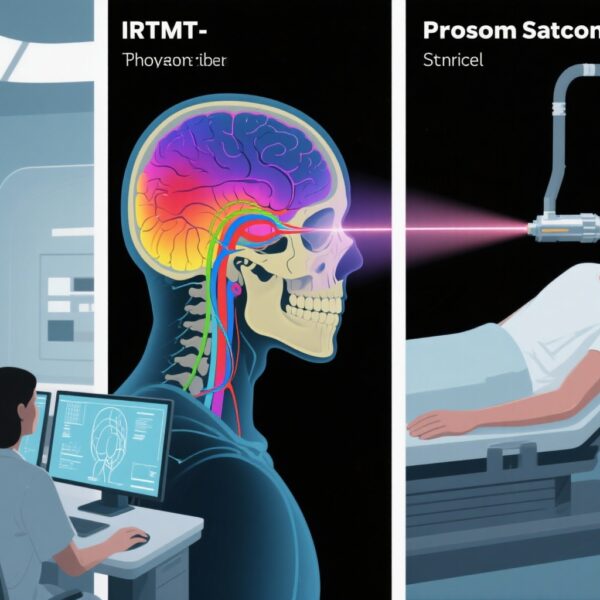Highlight
– In a pooled cohort (n=79) from two neoadjuvant nivolumab trials, a pathologic treatment effect (pTE) threshold of 57% defined responders versus low/nonresponders.
– Among 40 patients with HPV‑negative resectable HNSCC, pathologic responders (pTE >57%) had 100% 3‑year disease‑free and overall survival versus 66.8% and 73.3%, respectively, in low/nonresponders.
– In HPV‑positive disease, high 3‑year disease‑free survival was observed regardless of pTE, underscoring different prognostic baselines and implications for biomarker use by HPV status.
Background: clinical context and unmet need
Head and neck squamous cell carcinoma (HNSCC) comprises a heterogeneous group of tumors arising from the mucosa of the oral cavity, oropharynx, hypopharynx and larynx. Incidence and outcomes vary markedly by human papillomavirus (HPV) status: HPV‑positive oropharyngeal cancers typically carry a substantially better prognosis than HPV‑negative, tobacco‑related disease [Ang et al., NEJM 2010]. For patients with resectable disease, surgery (often with adjuvant radiotherapy or chemoradiotherapy based on pathologic risk factors) remains a cornerstone of curative therapy.
Immune checkpoint blockade (ICB) has become a standard option in recurrent/metastatic HNSCC (nivolumab improved overall survival in platinum‑refractory disease [Ferris et al., NEJM 2016]). Expanding ICB into earlier disease settings aims to increase cure rates and to identify early biomarkers that can guide adjuvant therapy intensity. Neoadjuvant immunotherapy permits an on‑treatment assessment of tumor immune response and pathologic regression; whether pathologic response predicts long‑term outcomes in HNSCC — and whether this differs by HPV status — remains an active research question.
Study design and methods
This work is a pooled cohort analysis combining two multi‑institutional neoadjuvant immunotherapy trials (ClinicalTrials.gov NCT03238365 and NCT03854032) enrolling between July 2017 and January 2022. Eligible patients had resectable HNSCC and received neoadjuvant nivolumab, in some cases combined with other investigational immunomodulatory agents (tadalafil or an indoleamine 2,3‑dioxygenase inhibitor), followed by definitive surgical resection. A total of 79 patients were included; 40 (51%) had HPV‑negative disease. Median follow‑up for survival outcomes was 36 months (range 4–72 months).
Primary analytic approach: pathologic treatment effect (pTE) was quantified on resection specimens and a threshold for response was identified using recursive partitioning analysis (a decision‑tree method that selects cut points predictive of outcome). Investigators compared 3‑year disease‑free survival (DFS) and overall survival (OS) between pathologic responders (pTE >57%) and low/nonresponders (pTE ≤57%), stratified by HPV status. Kaplan‑Meier survival estimates and confidence intervals were reported.
Key findings
Threshold derivation and responder prevalence: Recursive partitioning identified a pTE cut point of 57% as most strongly associated with survival distinctions in the cohort. Using this definition, pathologic responders represented a subset of patients with substantial tumor regression after neoadjuvant nivolumab.
HPV‑negative disease (n=40)
Outcomes at 3 years were striking in HPV‑negative patients classified as pathologic responders (pTE >57%):
– Disease‑free survival: 100% (no events reported among responders).
– Overall survival: 100%.
By comparison, HPV‑negative low/nonresponders had significantly worse outcomes:
– Disease‑free survival: 66.8% (95% CI, 46.1%–80.6%).
– Overall survival: 73.3% (95% CI, 53.4%–85.7%).
These differences indicate a strong association between a deep pathologic response and favorable long‑term outcomes in HPV‑negative HNSCC treated with neoadjuvant nivolumab.
HPV‑positive disease
In patients with HPV‑positive tumors, 3‑year DFS was high regardless of pTE: 90.0% for responders (95% CI, 47.3%–98.5%) and 92.4% for low/nonresponders (95% CI, 72.8%–98.1%). This suggests that the incremental prognostic discrimination provided by pTE is less pronounced in HPV‑positive disease, where baseline outcomes are already favorable.
Interpretation of safety and secondary findings
The pooled analysis primarily addressed association of pathologic response with survival and did not present detailed pooled safety outcomes in this summary. Because the analysis included neoadjuvant nivolumab given alone or with adjunct immunomodulators, toxicity profiles could differ across the cohort; however, prior neoadjuvant ICB studies have generally reported acceptable perioperative safety and no signal of increased surgical morbidity when administered before resection.
Expert commentary and critical appraisal
Clinical significance: The finding that a quantifiable pathologic response to neoadjuvant nivolumab correlates with near‑perfect 3‑year DFS and OS in HPV‑negative resectable HNSCC is potentially practice‑influencing. If validated, pTE could serve as an early surrogate biomarker to identify patients who derive durable benefit from neoadjuvant ICB and might be candidates for de‑escalation of adjuvant therapy or for omission of intensive adjuvant regimens in carefully selected cases.
Biologic plausibility: Pathologic regression after preoperative ICB reflects host antitumor immune activation within the intact tumor microenvironment. In other tumor types, major or complete pathologic responses after neoadjuvant ICB have been associated with improved outcomes (for example, major pathologic response in non‑small cell lung cancer after neoadjuvant PD‑1 blockade [Forde et al., NEJM 2018]). That the predictive value of pTE is concentrated in HPV‑negative disease may reflect the wider range of baseline prognoses and differing tumor‑immune biology between HPV subtypes: HPV‑positive tumors often have favorable natural history and distinct immune infiltrates that may blunt discriminative utility of an early pathologic metric.
Methodological strengths
– Multi‑institutional patient accrual and reasonably long median follow‑up (36 months) strengthen the clinical relevance of survival estimates.
– Use of a data‑driven method (recursive partitioning) to identify a pTE threshold avoids arbitrary cut points and helps generate a testable definition of response.
Limitations and caveats
– Sample size and event counts, especially within subgroup analyses, are modest. The number of HPV‑negative pathologic responders is likely small; estimates with small denominators are imprecise and susceptible to overestimation of effect size.
– Pooled analysis mixes slightly different neoadjuvant regimens (nivolumab alone versus nivolumab plus other immunomodulators), potentially introducing heterogeneity in biologic effect and toxicity.
– Pathologic treatment effect assessment requires standardized, reproducible scoring. Interobserver variability in estimating percent treatment effect or viable tumor can limit generalizability; harmonized pathology protocols and central review are needed for wider adoption.
– Observational (nonrandomized) cohort design: while pathologic response is temporally linked to treatment and plausibly predictive, causality (that neoadjuvant nivolumab causes survival benefit in responders) cannot be definitively established without randomized comparisons.
– Findings may not generalize to unresectable disease, to other ICB agents, or to broader community practice without confirmatory data.
Clinical and research implications
For clinicians treating resectable HNSCC, these data support continued investigation of neoadjuvant ICB strategies and suggest that pathologic response metrics could inform postoperative management decisions in HPV‑negative patients. Potential clinical pathways to test prospectively include using pTE to stratify adjuvant therapy intensity or to select patients for adjuvant observation
Priority research steps
– Prospective validation: randomized trials should test whether treatment decisions guided by pTE (for example, de‑escalation of adjuvant therapy in pathologic responders) maintain oncologic outcomes while reducing morbidity.
– Standardization: consensus on how to measure and report pTE (percent viable tumor, residual tumor burden, tumor regression grading) is essential to reproducibility and regulatory acceptance.
– Biomarker integration: combine pTE with molecular markers (circulating tumor DNA dynamics, tumor mutational burden, PD‑L1, immune gene signatures) to improve predictive accuracy.
– Subgroup refinement: clarify whether the pTE threshold and prognostic implications apply across tumor sites and in diverse patient populations, especially for HPV‑positive versus HPV‑negative disease.
Conclusion
This pooled analysis indicates that a deep pathologic treatment effect (pTE >57%) after neoadjuvant nivolumab is strongly associated with excellent 3‑year DFS and OS in patients with HPV‑negative resectable HNSCC. The result supports pTE as a promising early surrogate marker of long‑term benefit in this subgroup and strengthens the rationale for neoadjuvant immunotherapy strategies. Nevertheless, limitations of sample size, cohort heterogeneity, and nonrandomized design require cautious interpretation. Prospective validation, standardized pathology assessment, and integration with molecular biomarkers are necessary before pTE can be adopted as a routine guide to adjuvant therapy decisions.
Funding and clinicaltrials.gov
ClinicalTrials.gov identifiers: NCT03238365, NCT03854032. Funding and detailed sponsor disclosures are reported in the original publication (Moroco et al., JAMA Otolaryngol Head Neck Surg. 2025).
References
1. Moroco AE, Nunes K, Alnemri A, et al. Pathologic Treatment Effect and Survival in HPV‑Negative HNSCC Following Neoadjuvant Nivolumab. JAMA Otolaryngol Head Neck Surg. 2025 Jul 31:e251707. doi:10.1001/jamaoto.2025.1707. PMID: 40742583; PMCID: PMC12551806.
2. Ang KK, Harris J, Wheeler R, et al. Human papillomavirus and survival of patients with oropharyngeal cancer. N Engl J Med. 2010 Jul 1;363(1):24–35. doi:10.1056/NEJMoa0912217. PMID: 20428233.
3. Ferris RL, Blumenschein G Jr, Fayette J, et al. Nivolumab for Recurrent Squamous‑Cell Carcinoma of the Head and Neck. N Engl J Med. 2016 Nov 10;375(19):1856–1867. doi:10.1056/NEJMoa1602252. PMID: 27518437.
4. Forde PM, Chaft JE, Smith KN, et al. Neoadjuvant PD‑1 blockade in resectable lung cancer. N Engl J Med. 2018 May 3;378(21):1976–1986. doi:10.1056/NEJMoa1716078. PMID: 29567705.



